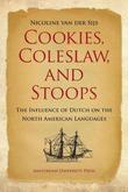Explore

Cookies, Coleslaw, and Stoops
Van Santa Claus (Sinterklaas) en zijn slee (sleigh) tot aan de dollar (vernoemd naar de daalder) en Yankees (Jan Kees), de Nederlandse taal is van grote invloed geweest op het Amerikaans-Engels. Yankees, cookies en dollars laat zien hoe de Nederlandse erfenis tot ver buiten New York reikt en zelfs terug te vinden is in de indianentalen. Dit jaar wordt herdacht dat vierhonderd jaar geleden, in 1609, Henry Hudson met zijn VOC-schip voor anker ging bij Manhattan. In zijn kielzog landden Nederlandse kolonisten op het eiland die de stad Nieuw-Amsterdam stichtten. In de loop van vierhonderd jaar is het gebied getransformeerd van landbouwgrond naar de huidige wereldstad New York. Hoewel er veel is veranderd, is de invloed van de Nederlandse taal nog steeds hoorbaar. Wat is de ontwikkeling geweest van het Nederlands in de Verenigde Staten? Hoelang is dit gesproken en is het ongewijzigd gebleven? Hoe groot was en is de invloed van het Nederlands op het Amerikaans-Engels? Welke Nederlandse woorden zijn door indianentalen overgenomen? In dit boek gaat taalkundige Nicoline van der Sijs in op deze en andere vragen. Ze geeft up-to-date informatie over de veranderende betekenis, de etymologie en de regionale spreiding van de Nederlandse leenwoorden. Cookies, Coleslaw and Stoops verschijnt ook in het Nederlands als "http://www.aup.nl/do.php?a=show_visitor_book&isbn=9789089641304">Yankees, cookies en dollars. In het kader van Holland on the Hudson (400 jaar handelsrelaties tussen Nederland en New York) wordt het boek op 10 september gepresenteerd op Columbia University te New York. Onder andere minister Ronald Plasterk van OC&W is hierbij aanwezig. "As a kid in New York's Mohawk Valley I played along the laag kill, called out Kip, Kip, Kip! to our chickens at feeding time, talked to friends on their stoeps after school, and got winklehawks in my blue jeans from scrambling through barbed wire fences. It wasn't until years later that I realized how many Dutch expressions survived in my dialect. This book is a linguistic treasure chest for anyone who grew up in the area covered by the Dutch colony of New Netherland." Charles Gehring, New Netherland Project, New York State Library
This book is included in DOAB.
Why read this book? Have your say.
You must be logged in to comment.
